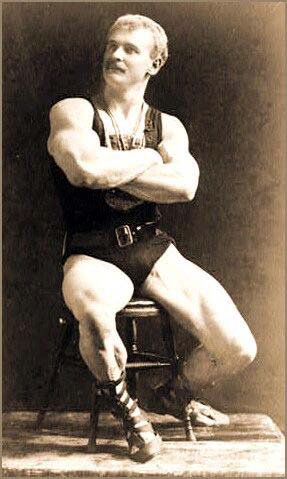Once I attain my measurements, how do I know what to shoot for? Well according to the models below, I'm very far away from those sizes. Take a look! We've got work to do!
The Grecian Ideal

Eugene Sandow
The ancient Greeks had a definite ideal regarding how the male physique should look. In the 19th century, newly excavated Greek and Roman statues highlighted similar physical characteristics such as a small, muscular waist, wide shoulders and detailed, but not overwhelmingly huge, muscles.
The great Eugene Sandow (the man the Mr. Olympia statuette is based on and the first man many regard to have achieved true muscularity) achieved close to this ideal around this time, and was widely revered for fitting what Victorian society, at that period, considered being the perfectly proportioned physique.
Through much analysis and determining of what constituted ideal physical measurements - the basis of any balanced physique - a "Grecian Ideal" calculator was formulated for self-assessment based on wrist size, to determine the individual body part circumference goals one should aspire to in order to develop the perfect physique.
The Steve Reeves Ideal Body Measurement
The physique of 1940s-1950s bodybuilding legend Steve Reeves will go down in history as being one of the most perfectly proportioned of all time. Many feel his body represents what a bodybuilding physique should look like - flawless and beautiful. His measurements (18.5-inch arms, calves and neck) were regarded as a benchmark for symmetry and proportion, and his philosophy was to keep the body balanced through the adherence to a couple of methods.
Height To Weight Chart For Building A Classic Physique ///
Reeves believed ones height represented the limit to which they could pack on mass. His main philosophy proposed keeping muscular bodyweight within acceptable limits to prevent the distortion of ones natural symmetry.
(My height is 6'0" and my weight on 12/03 is 169lbs.)- Jonas
| Height | Weight |
| 5'5" | 160lbs |
| 5'6" | 165lbs |
| 5'7" | 170lbs |
| 5'8" | 175lbs |
| 5'9" | 180lbs |
| 5'10" | 185lbs |
| 5'11" | 190lbs |
| 6'0" | 200lbs |
| 6'1" | 210lbs |
| 6'2" | 220lbs |
| 6'3" | 230lbs |
| 6'4" | 240lbs |
| 6'5" | 250lbs |
Muscle To Bone Ratios For Building The Classic Physique
To create the kind of ultra-symmetrical physique displayed by Reeves - where the all-important bone-to-muscle ratio conveys an illusion of greater size, while not detracting from overall aesthetics - use the following table, one that he himself endorsed.
For example: to determine your arm size, measure your wrist. Then multiply this measurement by 2.52 to get your proposed arm size.
Here are the results of my Reeves Physique Ratio test:
For the record, Steve Reeves measurement were:
- Arms: 18.5
- Calves: 18.5
- Neck: 18.5
- Thighs: 27
- Chest: 54
- Waist: 30
Aside from his waist measuring six inches less than twice the circumference of his neck, he almost reached his own ideal of the perfect physique.



No comments:
Post a Comment